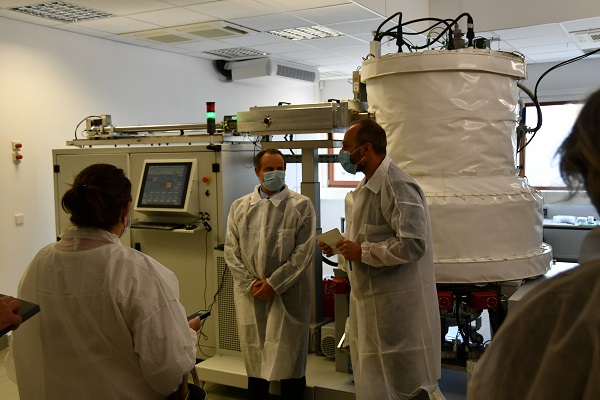 Credit: LIST
Credit: LIST
The Luxembourg Institute of Science and Technology (LIST) recently presented its newly installed hydrogen production equipment and provided an update on its second partnership with 3D-Oxides.
The partnership announced in June between LIST and the French company 3D Oxides is taking concrete shape. The planned joint laboratory has just opened with its first instrument installed and a second project was signed on Wednesday during a press conference held in Belvaux. The focus of all hydrogen research during this partnership is on making environmentally friendly water fractionation easier, efficient, and more affordable.
After an introduction by the Director of LIST’s Materials Research and Technology department, Damien Lenoble, LIST presented its new collaboration with 3D-Oxides which develops functional materials with extraordinary properties. Although the partnership actually began in June 2020, this was the first time the company’s President Christian Petit and Chief Technology Officer Giacomo Benvenuti were present along with LIST’s CEO Thomas Kallstenius to explain the collaboration. With the creation of a joint lab between LIST and 3D-Oxide, two projects are being researched and brand new innovative equipment installed.
The four-year partnership aims to conduct a research programme focused on energy, and in particular on the development of new materials for the hydrogen industry necessary for the creation of battery fuel with low catalyst content, the development of new generation electrolysers or high performance photolysis systems.
The ultimate goal of this joint-research is the acceleration of new materials discovery adapted to the challenges of hydrogen production and beyond.
Giacomo Benvenuti presented and demonstrated the new equipment named "Sybilla 450", which was recently installed at LIST in the new joint lab. Sybilla 450 is a unique machine that can treat substrates with diameters up to 450mm, a substantial size allowing the generation of photo-electrodes in large numbers or of sufficient size for relevant usage tests. 3D-Oxides is very experienced in processes known as CBVD (Chemical Beam Vapor Deposition), whilst LIST will bring its expertise in the synthesis of functional materials in thin layers, the characterisation of these materials and the prototyping of functional devices.
A completely new and innovative process together with a live contract signing for the joint-project took place in front of the press for this collaboration research between LIST’s CEO Thomas Kallstenius and 3D-Oxide President Christian Petit. This new project is known as STONB (Strontium Titanate Oxide with Narrow Bandgap) and will be led by Dr Emanuele Barborini. It is based on the observation that although in the short- to mid-term hydrogen economy can be initiated through fossil fuels, its long-term sustainability relies on other precursors as well as on production processes driven by renewable energy. In this respect, photo-electrochemical (PEC) water splitting by solar photons is considered the "perfect solution" - but this has still not been reached.
STONB is the second project resulting from the partnership. The first one was HEPHOTO, led by Dr Bianca Rita Pistillo and supported by the Luxembourg National Research Fund (FNR) via the Bridges programme. It aims at developing a functional material used in photo-electro-catalytic processes to separate hydrogen and oxygen. This approach will make it possible to obtain, in a single step, very efficient photo-electrodes making it possible to fractionate the water. Both projects received FNR funding.








